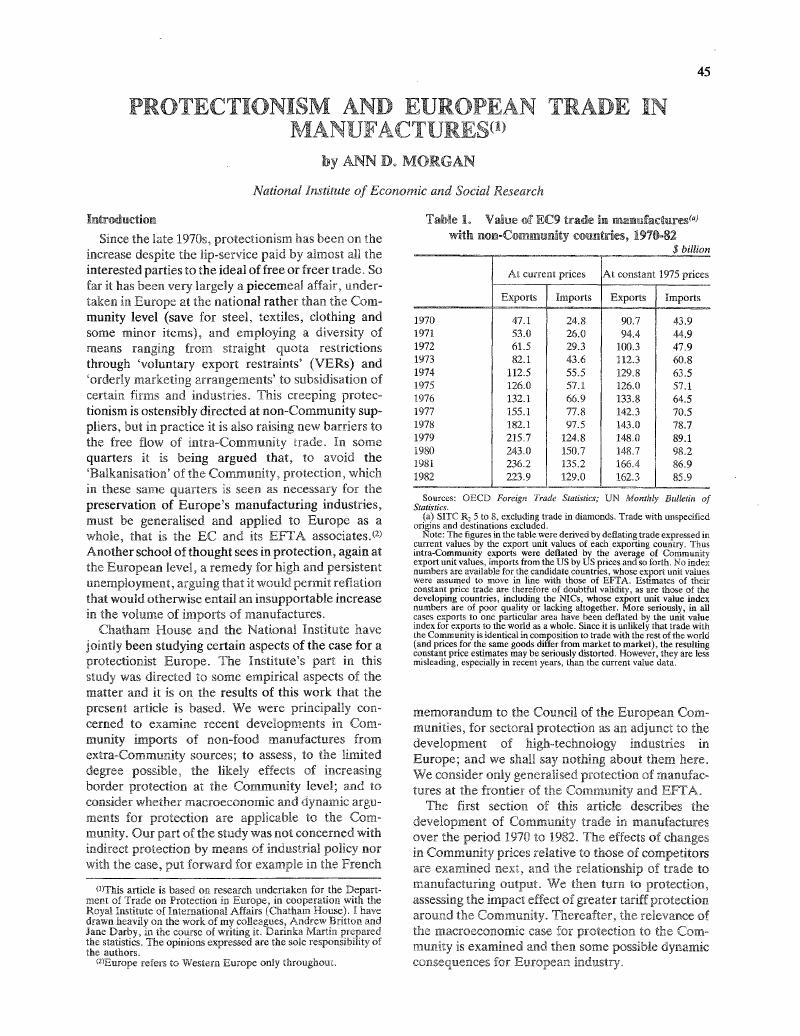No CrossRef data available.
Published online by Cambridge University Press: 26 March 2020

This article is based on research undertaken for the Department of Trade on Protection in Europe, in cooperation with the Royal Institute of International Affairs (Chatham House). I have drawn heavily on the work of my colleagues, Andrew Britton and Jane Darby, in the course of writing it. Darinka Martin prepared the statistics. The opinions expressed are the sole responsibility of the authors.
page 45 note (1) This article is based on research undertaken for the Depart ment of Trade on Protection in Europe, in cooperation with the Royal Institute of International Affairs (Chatham House). I have drawn heavily on the work of my colleagues, Andrew Britton and Jane Darby, in the course of writing it. Darinka Martin prepared the statistics. The opinions expressed are the sole responsibility of the authors.
page 45 note (2) Europe refers to Western Europe only throughout.
page 46 note (1) Manufactures are defined as SITC R2 5-8, excluding trade in diamonds, which is erratic and badly recorded.
page 46 note (2) Figures derived by deflating OECD export values by export unit values published in the UN Monthly Bulletin of Statistics, which is also the source for the value of developing country ex ports. The trade of Communist countries and of some small developed countries is excluded; trade in diamonds is included.
page 46 note (3) Although the UK, Denmark and the Irish Republic only joined the Community in 1973, it is convenient for purposes of comparison to treat them as part of the Community throughout. Greece, though now a member, has been grouped with Spain and Portugal since their trade with the Community is in many ways similar.
page 47 note (1) Unfortunately, it is not possible to calculate reliable constant price data nor to establish the shares of developing countries for separate commodity classes. It is probable that constant price data would give a more favourable picture of Community performance, but including developing countries' exports would imply much larger reductions in the Community's share in world markets.
page 49 note (1) Similar calculations relating import shares of all non-EC sup pliers as a group to relative prices did not yield significant results, possibly because among the non-industrial countries included in the total, unit value indices are particularly unreliable, because a high proportion of their sales to the Community are of complemen tary rather than competing products, and because competing pro ducts have increasingly been subject to physical restrictions.
page 51 note (1) For example, the premium paid for quota rights in Hong Kong ranges from 15 to 25 per cent, according to a report in Textile Asia quoted in Keesing, Donald B. and Wolf, Martin, Textile Quotas against Developing Countries, Trade Policy Research Centre, London 1980.
page 51 note (2) Additionally, VERs do not formally infringe the GATT.
page 52 note (1) Ranuzzi, P., ‘The bilateral trade linkages of the Eurolink Model: an analysis of foreign trade and competitiveness’, Economic Papers, No. 6, Commission of the European Com munities, Directorate-General for Economic and Financial Affairs, January 1982.
page 52 note (2) Strictly, the elasticity obtained from weighting together the individual member country elasticities should be adjusted for the effect of substitution away from outside suppliers to partner coun tries when extra-Community prices rise relative to partner and domestic prices for a member country.
page 52 note (3) Some of the elasticities in the interlink model were estimated from actual data; others were imposed.
page 52 note (4) Stern, R. M., Francis, J., Schumacker, B., Price Elasticities in International Trade, Macmillan 1976.
page 52 note (5) Stone, J. A., ‘Price elasticities of demand for imports and exports: industry estimates for the US, the EEC and Japan’, Review of Economics and Statistics, May 1979.
page 52 note (6) The method is explained in numerous sources, e.g. Cline, W. R., Kawanabe, N., Kronsjö, T. O. M. and Williams,T., Trade negotiations in the Tokyo Round, Washington DC, 1978.
page 53 note (1) Strictly speaking, the tariff-equivalent of quotas and other VERs should be taken into account in calculating the starting-point for the tariff increase, but in view of their multiplicity this is impossible. A corrected tariff would be higher, but probably only slightly so, than the existing tariff.
page 55 note (1) For a discussion of this point see Francis Cripps ‘Britain, Europe and Macroeconomic Policy’, in Jenkins, Roy (ed.) Britain and the EEC, Macmillan, 1983.
page 56 note (1) Owen, Nicholas, Economies of Scale, Competitiveness and Trade Patterns within the European Community, Oxford, 1983.
page 57 note (1) De Rosa, Dean A. and Goldstein, Morris, ‘Import discipline in the US manufacturing sector’, IMF Staff Papers, September 1981.